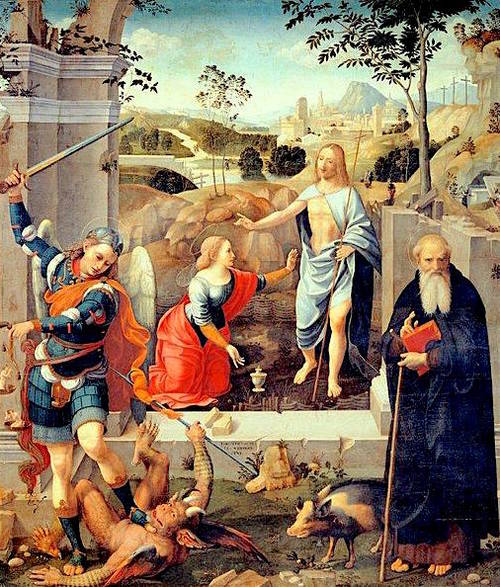
We were passing through Cagli and stopped there, drawn by the Blue Guide report of the La Gioconda which served us a wonderful lunch. It well deserves Ellen Grady’s accolade as ‘a fantastic little restaurant that will make you want to stay in Cagli forever’. Walking off our choices from the porcini menu, we discovered a treasure: halfway between the central square of Cagli, Piazza Matteotti, and the church of San Francesco, in the street named after the local 18nth century artist Gaetano Lupis, is a pretty 16th-century portico. There is a small oratory behind it. A fresh APERTO sign on the door entices you in, but in the first second as you enter, the oratory seems unlit. Then suddenly the altarpiece lights up, and there is this lovely painting by Timoteo Viti.
Viti was a native of Urbino, just a few years older than Raphael and a friend of both him and his father, although part of his training was in Bologna. He travelled widely in the Marche but collaborated with Raphael in Rome (in the church of Santa Maria della Pace) and this painting may reflect that influence. It appears freshly restored and shows Mary Magdalene reaching out towards the risen Christ. Between the two figures is the precious ointment mentioned in the gospels that was poured on Jesus by a woman, to the indignation of some of the onlookers. The woman is traditionally believed to be Mary Magdalene. Behind them is Jerusalem interpreted as if it were an Italian city of the day. The picture is enhanced by a richly-clothed Archangel Michael, the patron of the oratory, trampling on Lucifer and about to strike him with his sword. Opposite is the (4th-century) hermit St Anthony Abbot, with the pig that is a symbol of the medieval order of Hospitallers of which he was patron (the Hospitallers were allowed to support their work by raising pigs.)
It was a wonderful surprise to come across this painting and it should be included in the itinerary of all who visit this medieval town. As the oratory seems permanently open, one can visit it before or after lunch at La Gioconda!
by Charles Freeman, history consultant to the Blue Guides.






